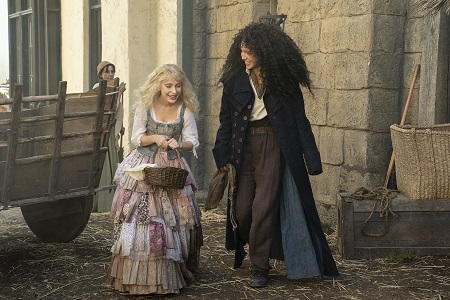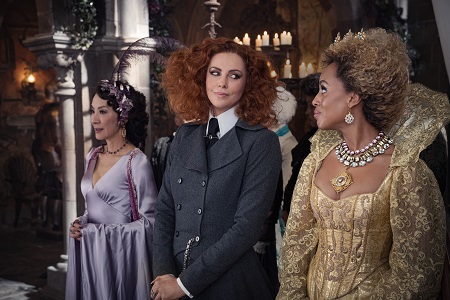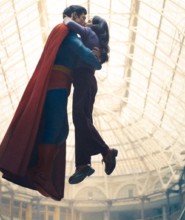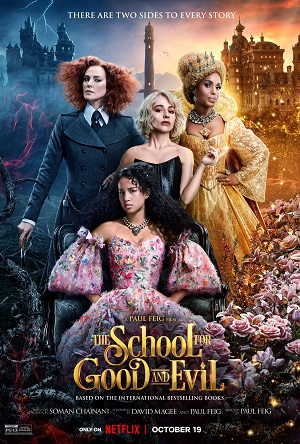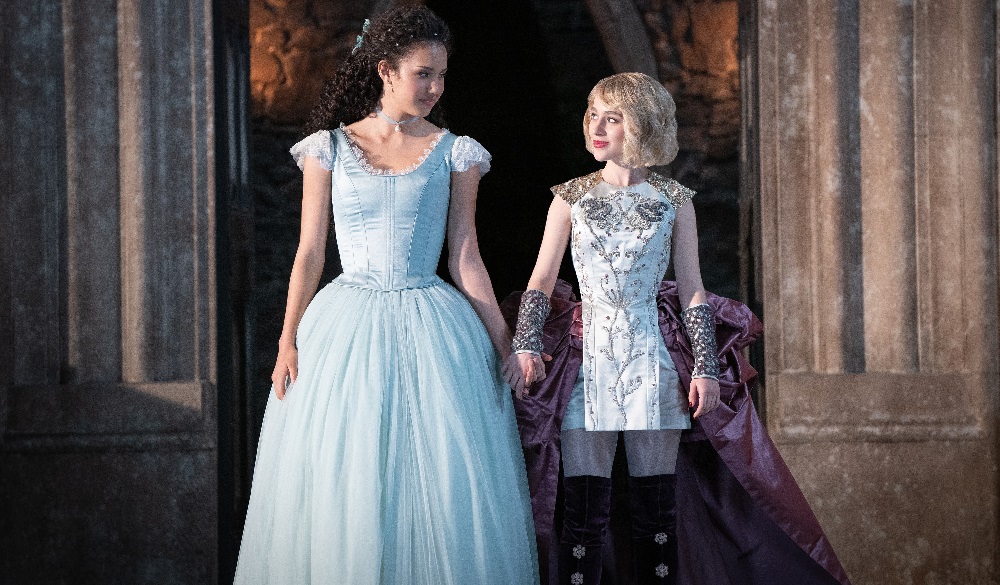
The School for Good and Evil (2022)
by Sara Michelle Fetters - October 19th, 2022 - Movie Reviews
Imaginative School for Good and Evil a Mixed Bag of Magic Tricks
Sophie (Sophia Anne Caruso) and Agatha (Sofia Wylie) have been best friends for most of their lives. The two teenagers — considered misfits and outsiders by the townsfolk of Gavaldon — both dream of better lives where they are not bullied, shamed, or made to feel inconsequential. Sophie fantasizes about becoming a beautiful princess — or at least someone who dresses them — while Agatha just wants people to leave her alone, stop calling her a witch, and not-so-sardonically threaten to burn her at the stake.
What happens next is what has made author Soman Chainani‘s seven-book The School for Good and Evil series so popular. Sophie and Agatha are magically transported to the learning institution of the title. The problem? The beauteous damsel-in-distress-wannabe Sophie gets dropped off on the “evil” campus, while her perpetually frowny-faced, frequently disheveled bestie lands among the fresh-faced, clean-scrubbed students who reside on the “good” side of the institute.
Comparisons to similar tales set at a wizarding school notwithstanding, the scenario Chainani has dreamt up is still pretty dang clever. It posits that all the classic stories of good versus evil are born inside the hallowed walls of this castle of higher learning. The children of everyone from Captain Hook to Robin Hood to King Arthur to the Evil Queen of Snow White fame are all enrolled, each learning who their arch nemesis is going to be, so they can help author the fictional narratives of never-ending, happily-ever-after tomorrows still to come.
Sophie and Agatha are known as “readers,” humans from the outside world that the wise School Master (Laurence Fishburne) and the all-knowing, sentient quill the Storian (voiced by Cate Blanchett) believe have what it takes to become vital members of the student body. But what no one knows is how big a part they’ll play in everyone’s futures — not just the students and teachers at the school but every soul on earth as well. They’ve been chosen by an unspeakably powerful force to change the balance between good and evil forever, and if either succumbs to temptation, they will unleash an armageddon too hellish to be believed.
Bridesmaids, Spy, and A Simple Favor filmmaker Paul Feig is at the helm of all this supernatural craziness, co-writing the film’s screenplay with two-time Academy Award nominee David Magee (Finding Neverland, Life of Pi). They pack in a ton of plot into 147 minutes (as tightly wound a as I’ve ever seen), and Feig keeps his foot pressed firmly down on the accelerator from the first scene to the last.
That isn’t necessarily a plus. There’s so much exposition being dumped by the School Master, the Storian, or the two headmistresses — Professor Dovey (Kerry Washington) at Good, Lady Lesso (Charlize Theron) at Evil — that a viewer could be forgiven if they imagined they missed something important (because they probably have). It’s all a little dizzying: there were moments where I wanted Feig to press pause and let the characters share a quiet cup of tea or eat a savory crumpet, so I could catch my breath.
The modernized touches also annoyed me. I think I’m at the point where throwing current slang and needle-dropping familiar pop and rock hits into a feature-length fantasy needs to take a hiatus. Feig does this sort of thing better than most, and in Caruso and Wylie he has two massively talented youngsters who can appealingly pull the dialogue off. But it is still tiresome, and by the time I got to a full-on battle royale set to Britney Spears’s “Toxic,” I could feel my eyes roll so far to the back of my head, I was positive they were about to burst out the other side.
But the film is visually eye-popping, as Feig mixes practical effects, physical sets, and CG images with creatively ambitious confidence. If any big-budget Netflix production deserves to be seen on the biggest screen possible, it is this one. Production designer Andy Nicholson (Gravity), costume designer Renee Ehrlich Kalfus (Hidden Figures), and cinematographer John Schwartzman (Seabiscuit) are all at the top of their games, while effects supervisor Erik Nordby (Passengers) and his gifted team craft colorfully ingenious visuals that continually impress.
Best of all are the aforementioned Caruso and Wylie. Whether on screen together or sharing it with one of their recognizable co-stars, both actors deliver powerful, three-dimensional performances overflowing with authentic, sometimes painful emotional nuances. If Netflix moves forward with more adaptations of Chainani’s source material, I’d be curious to see what else this duo could bring to the table.
On the negative side of the ledger, the teenage supporting players — especially those in the Evil dormitories — barely register, while fascinating subplots concerning what happens to students who receive three failing grades and where the various professors originally came from are never satisfyingly explored. Worst of all, Feig wastes Michelle Yeoh, Patti LuPone, and Rachel Bloom in stunt-casting throwaway roles. While I’m sure that’s because the director hopes they’ll get utilized more in potential future chapters, for this standalone entry, that’s still nothing less than unforgivable.
This adaptation does cast a spell, and there is power in seeing a universe populated by such a diverse group of characters who are not reduced to stereotype or culturally insensitive tropes, which was often the case in that world conceived by a certain wizarding author (she who shall not be named). But I’m not sure that’s enough. Feig’s film is nowhere near as fully realized or as creatively satisfying as I kept hoping it was going to be, making The School for Good and Evil a mixed bag of magic tricks.
– Review reprinted courtesy of the SGN in Seattle
Film Rating: 2½ (out of 4)


